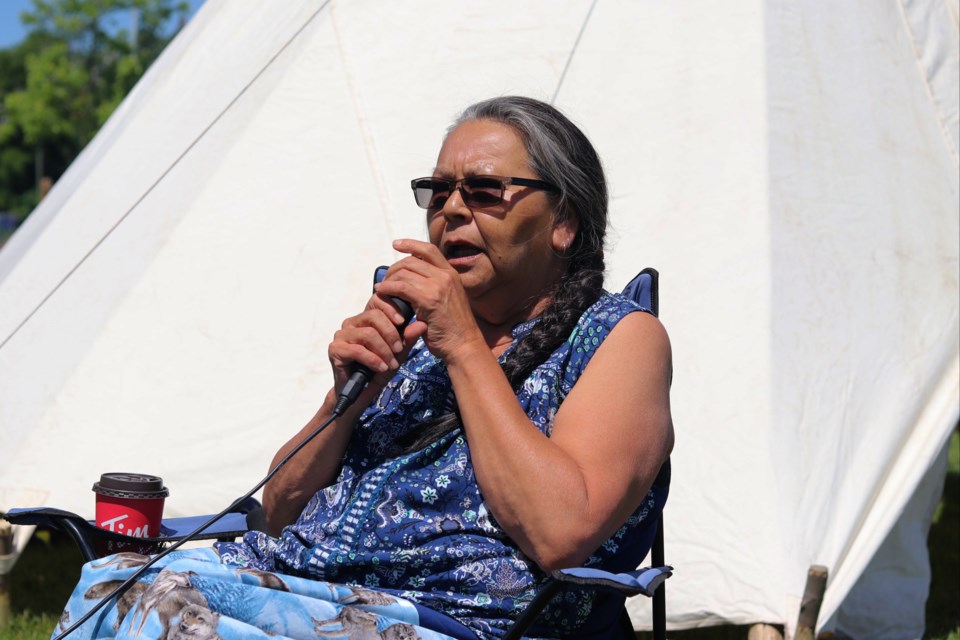Three years after Canada 150 demonstrations took place at Parliament Hill, Timmins resident Sophie Gunner-Sackabuckskum says it took her a long time to heal from what she describes as a traumatic experience.
Back in 2017, Gunner-Sackabuckskum said she brought her teepee to provide it as a shelter to the Bawating Water Protectors. The group arrived in Ottawa to oppose Canada’s 150th anniversary and were told they needed permits to set up the teepee, Gunner-Sackabuckskum recalled.
During a standoff with police, Gunner-Sackabuckskum lost a shoe and her walker was knocked over by the RCMP, she said.
“I couldn’t believe what was happening there. The confrontation that happened on Parliament Hill, it was terrible,” she said. “It was very traumatic for me. It took me a long time to heal from that.”
Gunner-Sackabuckskum spoke to a group of about 20 people gathered at Gillies Lake Monday about her experience being at Parliament Hill three years ago and on issues that Indigenous people face every day.
Before Monday's event kicked off, Gunner-Sackabuckskum was sitting inside the teepee, smudging.
“This teepee is iconic,” she said. “This is the first time we’re putting it up again here at Gillies Lake.”
“When I look at the teepee, I look at the struggles. I look at the struggles Indigenous people face every day. There are people out there that care and those are the ones that count.”
The event was spearheaded by Gunner-Sackabuckskum after she met Gérick Girard and Megan Guillemette at the anti-racism rally held earlier in June.
After the rally, Gunner-Sackabuckskum said she wanted to put up the teepee at Gillies Lake for the National Indigenous History Month and that's how the event came to be.
Because the original teepee poles were left in Ottawa, finding other poles was like looking for a needle in a haystack, Gunner-Sackabuckskum said. Eventually, 14 17-foot poles were found and brought to Timmins from Wahgoshig First Nation last night.
It was a team effort, Gunner-Sackabuckskum said, thanks to Roch Poitras, Julie Leroux, Jacob Coger, Stephane Belec, Renée deBlois and Isabelle Bigrais, who stepped forward and offered help whether it was to provide transportation to bring the poles or to help document the event.
A poster was also created for the event by Guillemette’s friend Erykah Hickey who finished the piece in two nights.
Gunner-Sackabuckskum praised everyone who helped to put the event together.
“This was all done with no money,” she said. “All we had was a teepee and our voices.”
As a Timmins resident who moved to the city from Moose Cree First Nation when she was young, Gunner-Sackabuckskum said the community used to be “very racial” but the situation is getting much better now.
What non-Indigenous people can do to help and be an ally is to listen, Guillemette noted.
“It’s a white privilege to choose to stay out of instances of injustice because Black and brown people have to live out these realities every single day,” she said. “The fact that we as white people have the option to turn a blind eye is privilege … The heart of the issue lies within the institutional structures that we set in place as well as how we socialize with each other.”
“Housing, mental healthcare for everyone, making sure everyone has food, that’s just the baseline. A lot of these are not in the power of the municipality, that’s why it’s a much larger issue,” Girard added.
“Giving back the control and the land to Indigenous peoples is I think the main goal. We all have to support people like Sophie who are taking that first step.”



